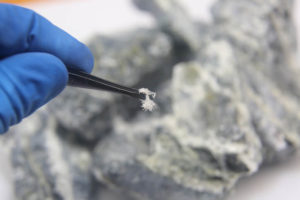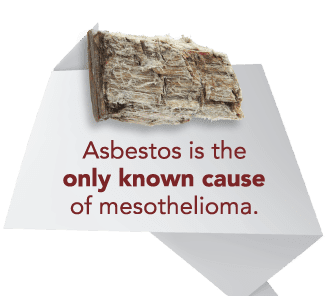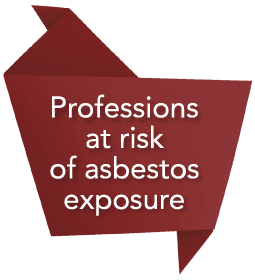What Is Asbestos?
 Asbestos is a naturally occurring mineral made up of long fibrous crystals. There are 6 types of asbestos, all of which are recognized as carcinogens (cancer-causing substances).
Asbestos is a naturally occurring mineral made up of long fibrous crystals. There are 6 types of asbestos, all of which are recognized as carcinogens (cancer-causing substances).
For the last several decades, studies have continued to link asbestos to health issues in humans.
Quick Facts about Asbestos
Asbestos is:
- A naturally occurring mineral
- Cheap to mine
- Incredibly light and durable
- Made out of microscopic fibers that bundle together
- Resistant to heat, electricity, and water damage
- Found in serpentine and mafic rock deposits across the globe
- The only known cause of mesothelioma, a rare and incurable cancer
Once mined, asbestos can be developed into valuable products for different industries. Asbestos-containing products are used in construction, shipbuilding, and manufacturing industries around the world.
Many companies stopped using asbestos in the 1980s once the public became aware of the health risks associated with it. However, some continue to use asbestos to this day.
Learn More about Asbestos Exposure & Mesothelioma
The Dangers of Asbestos Exposure
When asbestos fibers are disturbed, they can become airborne. If inhaled or ingested, asbestos fibers may become trapped in the linings of organs and result in deadly diseases.
Court records have shown that many companies knew asbestos-containing products could cause cancer and other illnesses for years, yet they did nothing to warn workers or consumers about these dangers.
Since asbestos-related diseases can take 20-50 years to develop, many people who were exposed to asbestos decades ago are now developing serious health issues.
Diseases Caused by Exposure to Asbestos
If you or someone you love has been exposed to asbestos, there is an increased risk of terminal illness later in life. When asbestos fibers enter the body, they make their way to major organs like the lungs, heart, and chest cavity.
Since asbestos fibers cannot be broken down, they irritate the affected areas for decades. Long-term irritation leads to scarring, fluid buildup, and the development of cancer in some cases.
Common asbestos-related diseases include:
- Mesothelioma: Mesothelioma is a rare form of cancer. It occurs when asbestos fibers get stuck in the linings of lungs, abdomen, or heart. As the damage worsens, cells begin to mutate and form cancerous tumors. Symptoms of mesothelioma vary depending on where it develops.
- Asbestosis: Asbestosis occurs when asbestos fibers get stuck in the lungs. As scar tissue and fluids build up in the lung, it gets stiffer. This makes it hard for the affected person to breathe. Symptoms of asbestosis include a constant cough and shortness of breath.
- Lung Cancer: Asbestos-related lung cancer is rare, but it can also occur as a result of exposure to asbestos. Unlike mesothelioma, lung cancer develops in the lung itself. Lung cancer symptoms are marked by a bloody cough, chest pain, and sudden weight loss.
There are no cures for either mesothelioma or asbestosis — but they can be managed with treatment if they are caught early on by doctors.
However, the symptoms of mesothelioma can often appear similar to common illnesses, delaying many diagnoses and allowing the cancer to spread, which can greatly reduce a person’s survival time.
As a national mesothelioma law firm, Sokolove Law has been helping victims of asbestos exposure hold the companies responsible for their illness accountable for over 45 years.
Get Help Paying for Treatment
Our asbestos lawyers can fight on your behalf for the compensation you need. Take the first steps toward justice now.
Asbestos-Related Deaths in the United States
Approximately 255,000 people die annually from asbestos-related diseases — with nearly 40,000 of these deaths occurring in the United States each year, according to the American Public Health Association (APHA)
For the past few decades, there have been attempts to ban asbestos use in the United States through asbestos legislation. However, the U.S. remains one of the few industrialized countries where asbestos is still legal for certain uses.
If you've been diagnosed with mesothelioma, the odds are fairly good it's not your fault. It wasn't from your tobacco smoking habit if you had one, and it wasn't from any other vice you can think of.
It was probably because you were exposed to asbestos in your job. That's likely how, you know, the vast majority of our clients are exposed.
Because it's not your fault and it should never have happened to you, you have a right to make a claim against the folks who knew it was gonna happen to you and did nothing about it. The average worker did not know that it was dangerous.
But the reason why we're able to bring claims against the manufacturers who used asbestos in their products is because they knew it was dangerous.
If you or a loved one has been diagnosed with mesothelioma, Sokolove Law is here to help. Call us today.
Occupations with High Risk of Asbestos Exposure
Due to its many valuable properties, asbestos was used across dozens of industries

High risk industries that may have exposed people to asbestos include:
- Aerospace: Aircraft mechanics were exposed to asbestos contained in brakes, brake linings, sealing gaskets, and insulation.
- Automotive: Asbestos was used in auto parts subject to friction like brakes, clutches, and gaskets.
- Construction: Asbestos was used in thousands of construction materials, putting workers who handled them at risk. Certain types of cement, roofing, plaster, wallboard, paint, and other products often used asbestos.
- Homemaking: The homes of asbestos workers may have been hotbeds for exposure, too. Wives of asbestos workers may have been exposed to the material from washing the dusty clothing of their husbands. Children who hugged their fathers upon returning from work were also exposed to asbestos.
- Manufacturing: Workers in plants where asbestos products were created are at a high risk of illness later on. Cement plants, steel mills, textile mills, and many other manufacturing plants may have put employees in danger.
- Metal Working: In the metal industry, protective clothing and work areas often used asbestos because it resisted heat and fire.
- Military: U.S. military veterans make up 1 in 3 of all mesothelioma patients. From World War II until the late 1970s, asbestos was used extensively in U.S. Navy ships, vehicles, military bases, and equipment.
- Railroad: Asbestos was used to insulate locomotives. It was also used in brake and clutch linings.
- Shipbuilding: Asbestos-based products were widely used aboard ships. Boilers, incinerators, hot water pipes, and steam pipes are just a few dangerous products. Asbestos was also used to soundproof rooms and protect engine rooms from heat.
You may be eligible for compensation that we can fight for on your behalf. Get the help you deserve now.
Asbestos Exposure Sites
Asbestos was used across residential, commercial, and industrial settings. As a result, many people may have been exposed to asbestos at work or at home.
Asbestos exposure sites that put individuals at risk include:
- Boiler rooms
- Construction sites
- Factories
- Garages/auto repair sites
- Home renovation sites
- Laboratories
- Military bases
- Older schools and homes built before the 1980s
- Power plants
- Ships and shipyards
- Utility companies
Even if you didn’t work directly in the asbestos industry, you could still be at risk. For example, some children and young adults have been diagnosed with mesothelioma after secondhand exposure to asbestos or being exposed to asbestos-containing products in their homes or schools.
Due to the widespread use of asbestos, there are many other potential exposure sites that are not widely known. An experienced asbestos and mesothelioma attorney with Sokolove Law can help determine where you may have been exposed.
Financial Compensation for Asbestos Exposure
If you or a loved one was diagnosed with an asbestos-related disease, you may be eligible to pursue compensation through an asbestos lawsuit or trust fund claim.
At Sokolove Law, we’ve recovered over $5.2 Billion for thousands of asbestos patients and their families nationwide. Let us get you the results you deserve.
Call (800) 647-3434 now to see if you have an asbestos exposure case our team can help with.
Asbestos Lawsuits
Asbestos and mesothelioma lawsuits help victims of asbestos exposure afford medical treatments, provide financial security for their families, and hold companies that manufactured asbestos-containing products accountable for their wrongdoings.
The majority of these lawsuits end in an asbestos settlement, with the company agreeing to pay the victim a set amount of money.
Average Mesothelioma Settlement Amount
If an amount cannot be agreed upon by both parties, your case may go to court. In this instance, your asbestos lawyer will prepare an argument to present at trial in hopes of securing a favorable verdict from a judge or jury.
At Sokolove Law, we provide free case reviews to determine your eligibility to file a lawsuit.
Asbestos Trust Funds
When the true dangers of asbestos were made public, thousands began to file lawsuits against the companies that had knowingly exposed them to this toxic mineral.
Many companies attempted to declare bankruptcy to avoid paying, but the U.S. government ordered these companies to establish asbestos trust funds for victims of asbestos exposure.
Estimated Amount in Asbestos Trust Funds
Asbestos trust fund claims do not require you to go to court, and you may begin receiving money in as few as 90 days. Depending on your situation, you may also be able to access compensation from multiple asbestos trust funds.
Get Compensation Without Going to Court
Our asbestos lawyers can determine if you’re eligible for asbestos trust fund compensation — at no cost to you.
VA Benefits for Military Asbestos Exposure
Asbestos was widely used throughout U.S. military bases and equipment. Today, veterans make up approximately 30% of all mesothelioma cases.
If you were exposed to asbestos while serving in the military and developed an asbestos-related disease, you may be able to receive health care and financial compensation through VA benefits.
VA Monthly Payment for Mesothelioma, Plus Free Health Care
Our VA-accredited lawyers can help guide veterans with mesothelioma and their families through the complex process of filing an asbestos-related VA claim.
Asbestos Properties
The use of asbestos dates back to Ancient Egypt. In modern history, asbestos has been used for over 100 years.
Starting in the late 1800s, it was commercially mined. By the 1930s, asbestos had become a key material for the construction and shipbuilding industries. Due to its number of seemingly useful applications, it would be widely used until the 1980s.
Properties of asbestos include:
- Abundance: Asbestos is found around the world, including in countries like the U.S., Canada, China, and South Africa. This abundance makes asbestos cheap to mine and sell. Given its uses and prevalence, asbestos became a billion-dollar industry.
- Durability: When asbestos-containing products were first manufactured, they were hailed for their strength and ability to resist heat, electricity, and flame. Asbestos fibers interlock and become nearly impossible to destroy. However, because these microscopic fibers are so tough, they will not easily leave your body if they are inhaled or swallowed.
- Fibrous: Asbestos is made up of thousands of tiny fibers. These fibers make asbestos lightweight. While this makes asbestos helpful for building and insulation, it can also cause problems. If asbestos is disturbed, its fibers can dislodge and become airborne. This makes the fibers easy for people to ingest or inhale.
- Insulation: Asbestos is resistant to fire, electricity, and water. It also is a natural soundproofing material. This makes it useful as an insulator for electrical wires, pipes, and walls, among other things.
Types of Asbestos
Currently, researchers have identified 6 types of asbestos, all of which are now known to be dangerous.
The different types of asbestos fall under two mineral families: amphibole and serpentine. Only chrysotile asbestos belongs to the serpentine family, while the rest belong to the amphibole family.
The 6 types of asbestos are:
- Actinolite: Actinolite asbestos was used in drywall, paint, and other materials. In its natural state, it exists in a few different colors like green, gray, and black.
- Amosite: Also known as “brown asbestos,” amosite asbestos was frequently used to make buildings. It is the second-most commonly used type of asbestos in the U.S.
- Anthophyllite: Anthophyllite asbestos is the rarest form of the mineral. As a result, it was only used occasionally in products like cement.
- Chrysotile: Chrysotile asbestos is the most common form of the mineral. It is made up of long, curly fibers. It is also known as “white asbestos.”
- Crocidolite: Crocidolite was used in products like cement and insulators. However, it isn’t as heat-resistant as other asbestos formations. It is also known as “blue asbestos.”
- Tremolite: Tremolite was used in consumer products like paint and talcum powder. It was known for its heat-resistant properties. Today, tremolite is no longer mined.
Amosite and crocidolite asbestos are considered to be more dangerous than the other types of asbestos. The fibers in these types are fine, sharp, and brittle. They easily become airborne when disturbed.
If you or a loved one became ill after being exposed to asbestos, call (800) 647-3434 or fill out our contact form today to see if you may be eligible to pursue financial compensation.
Sokolove Law: Providing Help for Asbestos Exposure
If you or someone you love was exposed to asbestos and developed concerning symptoms, see a doctor immediately and tell them about your asbestos history. They can determine if your symptoms are due to an asbestos-related disease.
At Sokolove Law, we have recovered over $5.2 Billion for injured clients across the country through asbestos litigation cases.
Let us help you and your family pursue compensation and justice through all of the avenues that may be available to you.
See if you can file an asbestos or mesothelioma legal claim today — our team is standing by to answer your questions 24/7.
Get started now by calling (800) 647-3434 or requesting a free case review.
Asbestos & Exposure Risks FAQs
Why is asbestos dangerous?
Breathing in stray asbestos fibers after they have been disturbed can lead to several fatal diseases, including mesothelioma, asbestos-caused lung cancer, and asbestosis.
It can take 20-50 years for symptoms of these diseases to appear.
Are asbestos tiles dangerous?
Yes, they can be. Though asbestos may be found in certain types of flooring and roofing tiles, it is commonly considered to be safe as long as it remains in good condition.
If, however, these tiles are damaged, destroyed, or disturbed (cracked, torn apart, or broken, etc.), they become dangerous and pose a major health risk to people.
Disturbed tiles can cause loose asbestos fibers to become airborne, which is when such asbestos poses its greatest risk.
Are asbestos shingles safe?
It depends. Asbestos shingles are on the exterior of your home. As long as they are kept in good condition and are not destroyed or damaged, they do not typically pose a serious health threat.
The presence of asbestos in a home, apartment, or building is not necessarily hazardous in and of itself. Rather, the threat to safety arises when asbestos-based materials and products get disturbed and microscopic asbestos fibers become airborne.
Airborne asbestos fibers can enter the body and accumulate within the lungs, stomach, or heart, which can cause diseases such as asbestosis or mesothelioma — the latter of which is a fatal cancer.
Damaged shingles must be removed immediately by a licensed professional.
When did asbestos get banned in the UK?
Two separate bans of asbestos occurred in the United Kingdom:
- First, in 1985, both amosite and crocidolite forms of asbestos were banned.
- Fourteen years later, on August 24, 1999, the U.K. banned chrysotile asbestos — a ban which came a mere month after the European Union (EU) called for a ban on chrysotile asbestos.
Deputy Prime Minister John Leslie Prescott signed The Asbestos (Prohibitions) (Amendment) Regulations, five years ahead of the proposed European deadline.
What do asbestos walls look like?
Because of asbestos’s naturally fibrous appearance, walls containing asbestos may appear white and stringy in composition, especially when they have been damaged, chipped, or disturbed.
Asbestos walls vary in appearance, though such walls can be identified due to distinctive connections between panels. Some cement wall sheets were stamped with asbestos identification marks during their production, but this practice was not common.
If you were exposed to asbestos at home, work, or elsewhere, you may be able to file a claim against the companies that made or sold the asbestos-containing products you came in contact with.
Contact Sokolove Law today for a free, no obligation case review.
Does asbestos make you itch?
Exposure to asbestos will not cause skin or throat itchiness or irritation. Likewise, asbestos will not cause a person to cough or sneeze unless the asbestos dust is produced in vast quantities.
However, coughing and trouble breathing are symptoms of mesothelioma and other asbestos-related diseases that may develop decades after asbestos exposure.
What do I do if I have asbestos in my house?
The mere presence of asbestos in your home is not necessarily hazardous. When asbestos is in the home, leave it alone. Do not damage or destroy it — this is when it becomes a major health-risk factor.
Generally speaking, materials containing asbestos that are kept in good condition will not pose a major health risk.
Asbestos was commonly used in many household materials before 1975, including:
- Vinyl floor tiles
- Window caulking and glazing
- Roofing materials
- Shingles
- Insulation
- HVAC duct insulation
- Siding material
- Plaster
- Some forms of paint
If you are worried about asbestos exposure in your house, the best course of action is to contact a certified asbestos abatement contractor who will help remove asbestos products from your house.
How is asbestos made?
Asbestos is a mineral that occurs in nature. It is not made by humans; rather, the mineral is mined.
Asbestos was used in the manufacturing processes of many industrial products throughout the 20th century due its natural strength, fireproofing qualities, and stringy, fibrous nature.
Is asbestos a hazardous waste?
Yes. Asbestos is a hazardous waste because it is carcinogenic and poses a threat to human health and safety.
Regulated by the Environmental Protection Agency (EPA), hazardous wastes are typically controlled and addressed by certain standards imposed by the government agency.
By EPA definition, a hazardous waste is any waste that can be dangerous or potentially harmful to human health or the environment. Hazardous waste exists in all states of matter — liquid, solid, and gas.
Is asbestos still used in brakes?
Asbestos is not still used in the production of new brakes, brake pads, and clutches. For many years, however, it was used as a fundamental component of brake pads and linings, as well as clutch facings and gaskets.
To this day, brakes and clutches on millions of cars, trucks, buses, and semi-trailers still contain high levels of asbestos in accordance with their time of production.
Is asbestos natural?
Yes. Asbestos is made from naturally occurring fibrous minerals found in rocks and soil.
It was heavily mined and eventually used commercially due to properties that proved useful in construction and fireproofing, like heat resistance, durability, and sound absorption.
Is asbestos poisonous?
Essentially, yes. Asbestos becomes poisonous when its fibers dislodge from asbestos-containing materials and separate into microscopic pieces.
These pieces, when released into the air, are small enough to be breathed into the lungs. Over time, they can then build up and become hazardous to health.
If the fibers are inhaled over long periods of time and continue to line the walls of the lungs, heart, or abdomen, it can increase the risk of diseases such as asbestosis, lung cancer, and mesothelioma.
If you or a loved one was exposed to asbestos and developed an asbestos-related disease, you may be eligible for financial compensation. Contact us today to learn more.
Is asbestos still used in the United States?
Unfortunately, yes. Asbestos has been banned in many countries throughout the world — but asbestos is still not entirely banned in the United States.
Some asbestos-containing materials have been prohibited by the U.S. Environmental Protection Agency (EPA), but other forms of asbestos are used in the U.S. for certain purposes.
Asbestos can still be used in the manufacture and processing of products like:
- Clothing
- Pipeline wrap
- Vinyl floor tile
- Roof coatings
Was asbestos used in popcorn ceilings?
Yes, sometimes. Textured ceiling paint — also known as popcorn ceiling — can contain asbestos. Asbestos was used in the construction of homes built between the early 20th century through the 1990s.
The U.S. Environmental Protection Agency (EPA) banned asbestos use in textured ceiling paint in 1978, but manufacturers were allowed to deplete any existing inventory.
Not all popcorn ceilings contain asbestos. The best way to find out whether your home’s ceilings were built with asbestos is to have a sample tested by a professional.
What does asbestos insulation look like?
Asbestos is a mineral made up of microscopic fibers or strands. In commercial settings, such as insulation, asbestos can appears as a thick, grayish fuzz.
However, asbestos is often invisible to the naked eye — either when airborne or contained in other materials, such as ceiling tiles or clothing.
If you have an asbestos-related disease, call (800) 647-3434 today to speak with our team and learn more about your legal options.
When is asbestos dangerous?
Asbestos can become dangerous when an asbestos-containing material is damaged or disturbed and its microscopic fibers are released into the air.
In this case, airborne asbestos can enter the body and, in many cases, pass into the lungs or digestive tract. When trapped inside the body, asbestos can cause dangerous health problems such as mesothelioma, which is a lethal cancer.
In general, however, asbestos is considered harmless when contained securely inside a material like those used in construction.
Where is asbestos commonly found?
Asbestos can be found inside or outside any industrial, residential, or commercial building built before the year 2000. The mineral can still be found in millions of American homes today.
Common parts of a building that may contain asbestos include:
- Floor tiles
- Ceiling tiles
- Cement shingles
- Insulation
- Soundproofing applications
- Paint or plaster
- Casing for electrical wires
Homes should be inspected by a professional to identify asbestos-containing products.
Who removes asbestos?
If asbestos is found inside a product or building, an accredited professional may determine that the product is likely to deteriorate or be disturbed.
In this case, it is important that the asbestos is handled and removed safely. If it is mishandled or not removed in a timely manner, asbestos can cause health concerns such as mesothelioma.
Government health and environmental agencies strongly recommend hiring a licensed asbestos removal contractor to assess what is required for removal and to then perform proper, safe removal and disposal.
Who discovered asbestos?
Asbestos use dates back to Ancient Egypt (at least 4,500 years), with specific uses developing throughout history.
Its toxicity was first discovered by German doctors in the 1930s, when they reported evidence of asbestos-related cancer. Doctors finally made firm conclusions that asbestos causes diseases such as mesothelioma in the 1960s.
Why was asbestos used in homes?
Asbestos was used in homes built between the 1930s and the 1990s because of its protective chemical and physical properties, like:
- Thermal stability
- Durability
- Electrical resistance
- Flexibility
- Affordability
Are asbestos roofs dangerous?
Asbestos roofs are harmless if they remain intact — but they become a health concern if they are damaged or disturbed in any way.
Where did asbestos come from?
Asbestos is a naturally occurring mineral that can be found in large deposits within rocks and soil worldwide.
The first commercial use of asbestos was located in Quebec, Canada in the 19th century, but asbestos use dates back at least 4,500 years.
Archaeologists have even found asbestos fibers in debris from the Stone Age.
What do asbestos fibers look like?
When asbestos fibers are tightly clustered, they have a light, fuzzy appearance. After processing, asbestos looks similar to silk or shiny synthetic material.
Because they can be virtually identical to fiberglass, asbestos fibers are difficult to identify visually. The individual fibers themselves are also invisible to the naked eye.
When contained within finished products are impossible to identify without professional inspection.
Does asbestos stay in the air?
Potentially, yes. Asbestos fibers may stay suspended in the air for hours, if not days, because they:
- Are so small
- Cannot evaporate into the air
- Do not break down over time
How does asbestos kill?
Asbestos is a known carcinogen. Asbestos-related diseases result in many symptoms and complications, so there is no single cause of death associated with asbestos.
It is most commonly associated with mesothelioma but is also linked to other diseases. Mesothelioma is a very aggressive cancer that attacks the linings of certain organs, including the lungs and heart.
In advanced stages, mesothelioma can cause organ failure and death. The cancer can metastasize, or spread, beyond the lungs and attack the brain, liver, or bones.
If you or a loved one became ill after being exposed to asbestos, our team is here to help. Call (800) 647-3434 or fill out our contact form today to learn more.
Is asbestos illegal in the United States?
No. Specific products with asbestos have been banned, but there are still many legal uses.
Asbestos is legally used in a variety of products, including:
- Automotive components
- Cement sheeting and pipe
- Clothing
- Floor tiles
- Roofing and plumbing materials
Asbestos is regulated by the Clean Air Act and the Toxic Substances Control Act (TSCA). In 1989, a rule issued in the TSCA banned most asbestos products, but the rule was overturned in 1991.
The result is that relatively few products containing asbestos are illegal in the United States.
Is asbestos in concrete?
Sometimes, yes. Asbestos was commonly used in concrete roofing, flooring, and insulation. There are hundreds of concrete insulation products that contain asbestos.
Asbestos cement, sometimes referred to as “transite,” was frequently used for water and sewage pipes from the 1940s to the 1960s.
Another compound, called soft concrete, was used in roofing because it was strong and lightweight. A majority of the asbestos mined worldwide is used in concrete products.
Should asbestos be removed?
The condition of materials containing asbestos should be considered carefully before removal. If asbestos removal is not done properly, risk of exposure can be increased. Undamaged materials are unlikely to release dangerous asbestos fibers, and should be left alone.
In the case of materials which are slightly damaged, it may be best to simply avoid that area. If asbestos-containing materials are in poor condition, they should be dealt with only by qualified professionals.
Materials with asbestos should not be dusted, swept, sanded, scraped, or otherwise disturbed. Home remodeling or major repair may require asbestos removal.
Where should asbestos be disposed of?
It is illegal to dispose of asbestos products in domestic waste bins. Asbestos waste must be kept wetted down and sealed in leak-tight containers and labeled before transport to a landfill.
Materials containing more than 1% asbestos cannot be crushed or incinerated. Not all landfill sites can legally accept asbestos waste, so the landfill operator should be contacted prior to removal.
Transportation of asbestos waste must be documented with a waste shipment record (WSR). The WSR must be signed by the people disposing of, transporting, and receiving the waste.
In some states, notice must be sent to a government agency before removal. Regulation of asbestos waste removal, transport, and disposal differs from state to state, so local authorities should be consulted.
Was asbestos used in insulation?
Asbestos may be present in vermiculite insulation. Most of the U.S. vermiculite came from a mine in Libby, Montana, which was contaminated by asbestos.
This vermiculite was often sold under the brand name Zonolite. Asbestos is most likely in houses that were insulated between the late 1920s and late 1980s.
Not all vermiculite insulation contains asbestos, but the Environmental Protection Agency (EPA) recommends that homeowners with vermiculite act under the assumption that it is contaminated with asbestos, and take the necessary precautions.
When did asbestos stop being used?
Asbestos is still used in a variety of materials and products worldwide. In the United States, particular uses of asbestos are outlawed under regulations issued by a number of agencies.
A 1989 EPA ban against most uses of asbestos was overturned in 1991, resulting in numerous legal uses of asbestos to this day.
When was asbestos used in homes?
Asbestos was used to insulate homes as late as the 1990s. Some construction materials and appliance components are still manufactured with asbestos today.
- In the U.S., asbestos is still legal in vinyl flooring, roof shingles and coatings, and other materials.
- Asbestos insulation for water heaters and other plumbing parts was not outlawed until the 1980s.
- Pipes laid prior to 1972 may contain asbestos, as well as textured ceilings predating 1978.
- Vermiculite insulation, which was widely used from the 1920s to the late 1980s, is often contaminated with asbestos.
Where is asbestos found in the home?
Asbestos was used to insulate and fireproof a variety of materials and appliances in the home.
Some places where asbestos can be found, especially in older homes, are:
- Vermiculite insulation
- Furnace gaskets and insulation
- Hot water heater insulation
- Pipe wrap and insulation
- Electrical panels
- Siding
- Roof tiles
- Stucco and ceiling coating
- Flooring felt, adhesives, and vinyl floor tiles
- Stove pads and sheeting
Where does asbestos waste go?
Asbestos waste goes to designated landfills. Materials containing more than 1% asbestos are considered hazardous waste if they can be crumbled using hand pressure when dry. Asbestos waste is regulated as an airborne hazard under federal law.
If a landfill compacts the waste, they must cover any asbestos with six inches of non-waste material before compacting. Asbestos waste must be kept wetted and bagged in at least 6mm of plastic.
Asbestos fibers can be safely degraded using thermal and chemical processes, and even recycled into stoneware and ceramic materials.
Which asbestos is the most dangerous?
There are six types of asbestos, all of which are carcinogens. Also known as blue asbestos, crocidolite is the most hazardous.
Blue asbestos is harder and more brittle than other kinds, making it more likely to release dangerous airborne fibers. However, crocidolite makes up a small percentage of asbestos used in the United States.
Chrysotile asbestos was the most commonly used and accounts for most cases of asbestos-related health problems.
Why is asbestos bad?
Asbestos is a known carcinogen, which means it is a risk factor for cancer, including lung cancer and mesothelioma.
If asbestos fibers are ingested or inhaled, they can caused a number of serious health problems. When breathed in, asbestos fibers irritate and scar the lungs, causing numerous health issues to develop decades later.
Other associated lung conditions, like pleural plaques and thickening, are less serious, but may still impair the lungs.
If you or a loved one was diagnosed with an asbestos-related disease, don't delay. Contact Sokolove Law for a free case review to find out if you are eligible to pursue financial compensation.
Why was asbestos used?
Asbestos has a number of attractive properties for construction and manufacturing.
Asbestos is:
- Abundant
- Affordable
- Fireproof and heat-resistant
- Lightweight
- Strong
As a result, asbestos can be used in a wide variety of products, including cement, plastics, paper, fabric, coatings, and adhesives.
Why was asbestos so popular?
Asbestos was popular because it's:
- Cheap to buy
- Does not conduct electricity
- Fireproof
- Lightweight
- Resistance to heat
- Resistance to many chemicals
- Strong
Many companies continued to use asbestos products despite knowing that they could be harmful to human health.
As a result, those impacted by asbestos exposure may be able to take legal action against these companies and pursue financial compensation.
Get a free legal case review today to learn if you are eligible to file a claim against asbestos-related companies.
Why is asbestos banned?
Asbestos bans were passed because asbestos exposure causes a number of very severe health problems, including:
- Asbestosis
- Mesothelioma
- Lung cancer
- Other lung diseases and gastrointestinal cancers
Modern medical professionals documented asbestos-related health problems as early as the turn of the 20th century.
Asbestos is banned in many countries throughout the world, though not in the United States.




